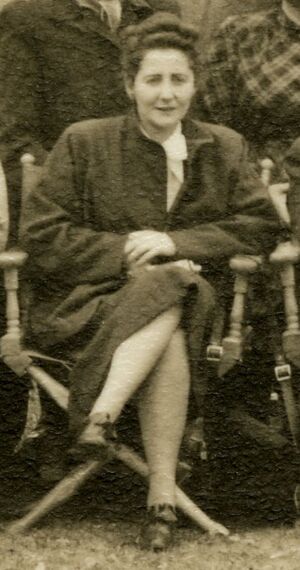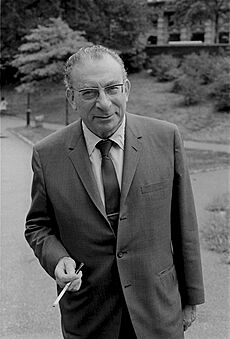Elisabeth Geleerd facts for kids
Quick facts for kids
Elisabeth Geleerd
|
|
|---|---|

Geleerd in 1950
|
|
| Born |
Elisabeth Rozetta Geleerd
March 20, 1909 Rotterdam, Netherlands
|
| Died | May 25, 1969 (aged 60) New York City, US
|
| Occupation | Psychoanalyst |
| Spouse(s) |
Rudolph Loewenstein
(m. 1946) |
Elisabeth Rozetta Geleerd Loewenstein (born March 20, 1909 – died May 25, 1969) was an important psychoanalyst from the Netherlands who later lived in America. She was born in Rotterdam to a well-off family. Geleerd studied psychoanalysis in Vienna and then in London, learning from Anna Freud, a famous psychoanalyst.
After moving to the United States, she became a leading expert in helping children and teenagers with their mental health. Geleerd focused on understanding and treating serious mental health conditions like psychosis, which includes schizophrenia. She wrote a lot about how psychoanalysis could help children with these conditions. She was also one of the first people to think about a condition called borderline personality disorder in children.
Geleerd married another psychoanalyst, Rudolph Loewenstein, in 1946. They had one child together. People knew her as a very caring and skilled therapist. She was also an independent thinker who wasn't afraid to share her ideas, even on difficult topics. Geleerd lived with a long-term illness for much of her life and passed away in New York in 1969 at the age of 60.
Contents
Elisabeth Geleerd's Early Life
Elisabeth Rozetta Geleerd was born on March 20, 1909, in Rotterdam, Netherlands. She was the oldest of three children in a Jewish family. Her father, Moses, was a successful businessman who supplied ships. This meant Geleerd grew up in a wealthy family.
When Geleerd was young, her mother, Bertha, was often sick with tuberculosis. Her mother died from the illness when Geleerd was nine or ten years old. Elisabeth and her two brothers, Yap and Benedictus, then went to live with their aunt. This was a hard time for her. She later returned to live with her father. Her father was busy with work, but he supported her dream of becoming a doctor.
A few years after her mother's death, Geleerd's brother Yap also died from tuberculosis. These sad experiences inspired her to study medicine. She earned her medical degree in 1936 from the University of Leyden. After that, she went to Vienna to study psychoanalysis with Anna Freud. Her studies at the Vienna Psychoanalytic Institute were seen as a brave choice for her time. In 1938, the rise of the Nazis in Austria forced her to move to London to finish her training. She helped other psychoanalysts who were also fleeing Vienna.
At the same time, her father and surviving brother moved away to escape the Nazis in the Netherlands. This meant Geleerd lost her connections to her home country. She had a complicated relationship with the Netherlands, feeling like she didn't quite belong there.
Starting Her Career in Psychoanalysis
Elisabeth Geleerd continued her studies with Anna Freud in London. She became one of Freud's most talented students. Geleerd was known for her independent thinking. She could present her ideas strongly, even if others found the topics difficult to discuss. Anna Freud later mentioned Geleerd's research in some of her own important books. While in London, Geleerd worked as a psychiatrist at the Maudsley Hospital. She also helped French war refugees at the Tavistock Clinic.
In 1940, Geleerd moved to the United States. Friends who were already living there encouraged her to come. She first settled in Topeka, Kansas. There, she worked at Karl Menninger's Menninger Clinic for several years. During World War II, she encouraged parents to talk to their children about the war. She believed it was better for children to understand what was happening than to be kept in the dark. This idea came from her experience helping children affected by war in London.
In 1946, Geleerd moved to New York City. She married fellow psychoanalyst Rudolph Loewenstein. They had a son named Richard Loewenstein, who also became a psychiatrist. Geleerd managed her family life and work even though she had a long-term illness.
In 1947, she became a training analyst at the New York Psychoanalytic Institute. This meant she helped train new psychoanalysts. She played a key role in creating programs for child and adolescent psychoanalysis there. In 1955, she joined the Institute's Educational Committee. Around the late 1940s or early 1950s, she spent six months at Mount Sinai Hospital. She helped set up their child psychiatry department.
Important Work in Child Psychoanalysis
Geleerd was an expert in psychoanalysis for children and teenagers. Because of her role at the New York Psychoanalytic Institute, she was one of the most important psychoanalysts in America during the mid-20th century. She was especially interested in understanding childhood schizophrenia. At that time, many conditions were called childhood schizophrenia that are now known as autism spectrum disorders.
In 1946, Geleerd wrote a paper about children with behavior problems. She thought these children might develop schizophrenia. She believed their behavior issues were signs of a serious mental condition. She argued that psychoanalysis could help these children. She said it "may have favorably influenced the course" for those who received it.
Geleerd was also one of the first psychoanalysts to think about borderline personality disorder in children. In 1958, she wrote about different groups of children. She connected one of these groups to borderline personality disorder as seen in adults. Her ideas were later developed by other researchers in the 1960s and 1970s.
Geleerd followed the "Freudian" or "classical" way of thinking about child psychoanalysis. She disagreed with the "Kleinian" school, led by Melanie Klein. While she accepted some Kleinian ideas, like how important the first year of life is for development, she disagreed with most of their methods. Geleerd was especially critical of the Kleinian idea of giving children "all possible freedom of observation" during therapy. She believed that stricter methods were needed for treatment.
In 1968, Geleerd edited a book called The Child Analyst at Work. This book shared real-life examples of how Freudian child psychoanalysis worked. It was created because there were books explaining the Kleinian approach, but not the Freudian one. Reviewers said the book was a great look at classical child analysis. They also said it was a good introduction to the subject, even if it was a bit complex for beginners.
Through her work, Geleerd became known as a very skilled and caring psychoanalyst. People described her as having "unusual sensitivity and empathy for the young." She focused on helping people with severe mental health issues and psychosis. Schizophrenia was a major focus of her career and many of her writings.
Later Life and Passing Away
In the 1960s, Geleerd started to focus on how people use defense mechanisms, like denial and regression, in healthy ways. She was especially interested in how these defenses play a role in normal teenage development. This idea was also explored by Jean Piaget. When she passed away, she was working on a book about teenage psychoanalysis and development.
Elisabeth Geleerd died in New York City on May 25, 1969. She was 60 years old. Her death came less than a month after she spoke at a meeting of the American Psychoanalytic Association. Her husband passed away in 1976, and her teacher Anna Freud died later as well.
Selected Works
- The Child Analyst at Work. New York: International Universities Press, 1967.
- "Child Analysis: Research, Treatment and Prophylaxis" (1964), Journal of the American Psychoanalytic Association, vol. 12, no. 1, pp. 242–258.
- "Some Aspects of Ego Vicissitudes in Adolescence" (1961), Journal of the American Psychoanalytic Association, vol. 9, no. 1, pp. 394–405.
- "Borderline States in Childhood and Adolescence" (1958), The Psychoanalytic Study of the Child, vol. 13, no. 1, pp. 279–295.
- "The Psychoanalysis of a Psychotic Child" (1949), The Psychoanalytic Study of the Child, vol. 3, no. 4, pp. 311–332.
- "A Contribution to the Problem of Psychoses in Childhood" (1946), The Psychoanalytic Study of the Child, vol. 2, no. 1, pp. 271–291.


